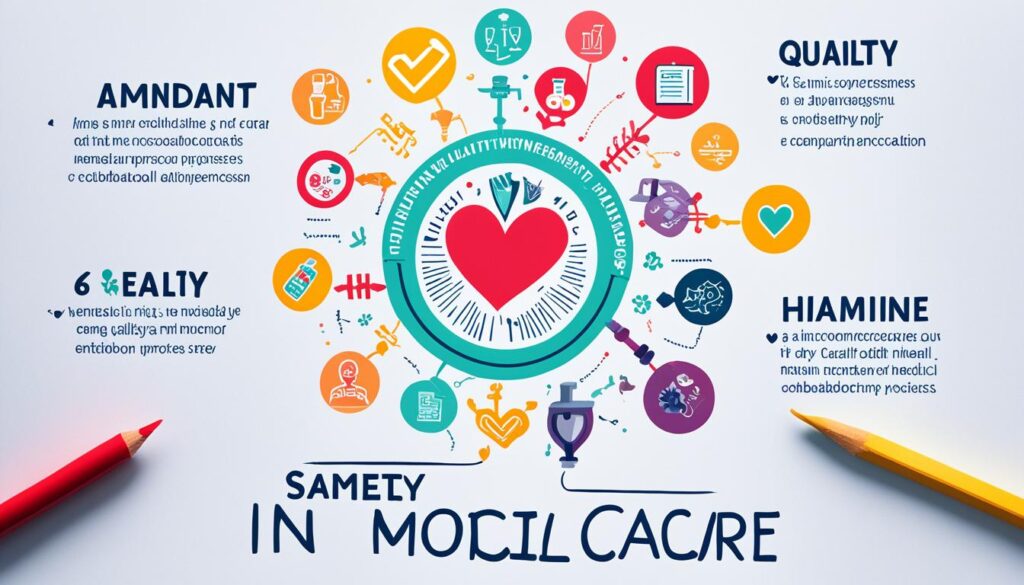In the dynamic landscape of medical healthcare, the focus on quality improvement has become increasingly paramount. Quality measures in medical health care play a vital role in enhancing patient outcomes by setting comprehensive standards for clinical practices, preventive care, and healthcare accessibility. By concentrating on six key areas – safety, effectiveness, timeliness, efficiency, equity, and patient-centeredness – quality improvement initiatives in the healthcare sector can significantly enhance patient safety, improve clinical outcomes, and increase the overall efficiency and cost-effectiveness of care delivery.
At the heart of this quality-driven transformation are innovative quality improvement strategies, such as Continuous Quality Improvement (CQI), Six Sigma, and Lean methodology. These approaches leverage systematic data analysis to drive targeted changes to healthcare processes and systems, ultimately leading to tangible improvements in patient outcomes.
Key Takeaways:
- Quality measures in medical health care set standards for clinical practices, preventive care, and healthcare accessibility
- Quality improvement initiatives focus on six key areas: safety, effectiveness, timeliness, efficiency, equity, and patient-centeredness
- Strategies like CQI, Six Sigma, and Lean methodology use data analysis to drive changes in healthcare processes and systems
- Patient outcomes are enhanced through improved safety, clinical effectiveness, and cost-efficiency
- Quality improvement is a collaborative effort involving healthcare professionals at all levels
Understanding Quality Measures in Health Care
Quality measures in healthcare are essential tools used to quantify various aspects of care, including healthcare processes, patient outcomes, perceptions, and organizational structure and systems. The purpose of these quality measures is to assess the degree to which a healthcare provider or health system delivers care that is safe, timely, effective, efficient, equitable, and patient-centered.
Definition and Purpose
Quality measures in the healthcare industry are designed to evaluate the performance and quality of care provided by healthcare organizations, providers, and systems. These measures help healthcare stakeholders, including patients, payers, and policymakers, understand the quality of care being delivered and identify areas for improvement. The primary purpose of quality measures is to ensure that patients receive high-quality, safe, and effective healthcare services that meet their needs and preferences.
Types of Quality Measures
There are several types of quality measures used in the healthcare sector, each focusing on different aspects of care delivery. These include:
- Process measures – Evaluate the steps taken by healthcare providers to deliver care, such as adherence to best practices or guidelines.
- Outcome measures – Assess the results of healthcare interventions, including patient health status, mortality rates, and patient-reported outcomes.
- Structure measures – Examine the organizational characteristics of healthcare providers, such as staffing levels, technology, and facilities.
By utilizing a combination of these quality measures, healthcare organizations can gain a comprehensive understanding of their performance and identify opportunities for quality improvement initiatives that enhance patient health care and outcomes.
The Importance of Quality Improvement

Quality improvement is essential for enhancing patient safety, improving clinical outcomes, and increasing the efficiency and cost-effectiveness of healthcare delivery. By systematically analyzing data on healthcare processes and outcomes, quality improvement initiatives can identify opportunities to reduce medical errors, prevent healthcare-associated infections, and optimize care coordination.
Enhancing Patient Safety
Through the implementation of quality improvement strategies, healthcare organizations can significantly improve patient safety by addressing issues such as medication errors, healthcare-associated infections, and other adverse events. By using data-driven approaches to identify and mitigate potential risks, quality improvement efforts help create a safer environment for patients and enhance the overall quality of care.
Improving Clinical Outcomes
Quality improvement initiatives play a crucial role in driving better clinical outcomes for patients. By analyzing data on treatment effectiveness, care coordination, and patient-reported outcomes, healthcare providers can implement evidence-based practices and personalized interventions to improve the management of chronic conditions, enhance preventive care, and optimize medical treatments.
Increasing Efficiency and Cost-Effectiveness
The implementation of quality improvement strategies can also lead to increased efficiency and cost-effectiveness within the healthcare system. By identifying and eliminating waste, streamlining workflows, and optimizing resource utilization, quality improvement efforts help healthcare organizations deliver high-quality care while also improving the financial sustainability of the healthcare delivery model.
Quality improvement is a collaborative effort involving healthcare professionals at all levels to create an organizational culture focused on continuous learning and improvement. By working together to achieve the shared goals of enhanced patient safety, improved clinical outcomes, and increased efficiency and cost-effectiveness, healthcare organizations can drive meaningful and lasting changes that benefit patients, providers, and the broader healthcare system.
Quality Improvement Strategies

Healthcare organizations utilize a variety of quality improvement strategies to drive systematic changes that enhance the quality and safety of care. These approaches share a common emphasis on using data, engaging multidisciplinary teams, and fostering a culture of continuous learning and improvement.
Continuous Quality Improvement (CQI)
Continuous Quality Improvement (CQI) is a collaborative, data-driven approach that seeks to identify opportunities for improvement in every healthcare process. By continuously analyzing performance metrics and soliciting feedback from frontline staff and patients, CQI initiatives enable healthcare providers to make evidence-based changes that enhance the quality, safety, and efficiency of care delivery.
Six Sigma
Six Sigma is a data-driven quality improvement methodology that focuses on reducing variation and defects in healthcare processes. Using statistical tools and rigorous data analysis, Six Sigma projects aim to identify and eliminate the root causes of quality issues, ultimately improving patient outcomes and organizational performance.
Lean Methodology
Lean methodology is a quality improvement approach that emphasizes the elimination of waste and the optimization of workflow. By engaging frontline staff to streamline processes and remove non-value-added activities, Lean initiatives can improve efficiency, reduce costs, and enhance the patient experience in healthcare settings.
| Quality Improvement Strategy | Key Focus | Outcomes |
|---|---|---|
| Continuous Quality Improvement (CQI) | Continuous data analysis and process improvement | Enhanced quality, safety, and efficiency of care delivery |
| Six Sigma | Reducing variation and defects in processes | Improved patient outcomes and organizational performance |
| Lean Methodology | Eliminating waste and optimizing workflow | Increased efficiency, reduced costs, and enhanced patient experience |
Role of Data and Benchmarking

Data plays a central role in quality improvement efforts within the healthcare industry, enabling organizations to measure performance, identify areas for improvement, and track the impact of change initiatives. Quality improvement professionals collect and analyze data on key performance indicators, such as medication errors, hospital-acquired infections, and patient satisfaction. This data-driven approach is essential for driving evidence-based changes that enhance the quality, safety, and efficiency of healthcare delivery.
Data Collection and Analysis
The systematic collection and analysis of data is crucial for healthcare organizations to understand their current performance and identify opportunities for improvement. Quality improvement teams gather data on a range of metrics, including medication errors, hospital-acquired infections, and patient satisfaction. By closely examining this data, they can pinpoint areas where processes or systems may be falling short, enabling targeted interventions to address these issues.
Internal and External Benchmarking
Once data has been collected and analyzed, healthcare providers can leverage it for both internal and external benchmarking. Internal benchmarking allows organizations to compare their performance over time, identify best practices within the institution, and track the impact of quality improvement initiatives. External benchmarking against national, state, or industry standards enables healthcare providers to gauge their performance relative to their peers and recognize opportunities for further quality improvement.
The systematic use of data and benchmarking is essential for driving evidence-based changes that enhance the quality, safety, and efficiency of healthcare performance. By leveraging these tools, healthcare organizations can make data-informed decisions and implement targeted quality improvement strategies that lead to better patient outcomes.
Medical Health Care Quality Improvement Initiatives

Healthcare organizations implement a variety of quality improvement initiatives to address key areas of concern and enhance patient outcomes. One critical focus is on reducing medication errors, which can significantly compromise patient safety and lead to adverse drug events. Initiatives in this area often involve implementing barcode medication administration systems and clinical decision support tools that provide real-time guidance to clinicians, helping to prevent medication mix-ups and dosage errors.
Reducing Medication Errors
By leveraging healthcare technology and evidence-based practices, hospitals and medical facilities can make substantial strides in minimizing medication errors. These quality improvement efforts not only improve patient safety, but also contribute to better clinical outcomes and reduced healthcare costs associated with adverse drug events.
Preventing Hospital-Acquired Infections
Another vital quality improvement initiative in the medical health care sector focuses on preventing hospital-acquired infections (HAIs). Strategies to combat HAIs, such as enhancing hand hygiene compliance and implementing evidence-based care bundles, help protect vulnerable patients from healthcare-associated complications. These initiatives are crucial for safeguarding patient well-being and reducing the burden of healthcare-associated infections on the overall healthcare system.
Improving Care Coordination
Enhancing care coordination is another key quality improvement focus in medical health care. By strengthening communication between providers, educating patients, and implementing transitional care programs, healthcare organizations can drive improvements in clinical outcomes, reduce readmission rates, and ultimately lower overall healthcare costs. Effective care coordination ensures that patients receive seamless, high-quality care throughout their healthcare journey.
The Six Aims of Quality Improvement

The Institute of Medicine has identified six key aims that should guide quality improvement efforts in healthcare: safe, effective, timely, efficient, equitable, and patient-centered care. These six aims provide a comprehensive framework for healthcare organizations to improve the quality, safety, and value of the care they deliver.
Safe Care
Safe care focuses on avoiding harm to patients during medical treatment. By implementing systems and processes that enhance patient safety, healthcare providers can protect vulnerable individuals from adverse events, such as medication errors or healthcare-associated infections.
Effective Care
Effective care ensures that patients receive services that are likely to result in better outcomes. Quality improvement initiatives in this area often involve the adoption of evidence-based practices, the use of clinical decision support systems, and the continuous evaluation of patient outcomes to drive improvements in care delivery.
Timely Care
Timely care reduces wait times and delays for appointments and treatment. By optimizing workflows, enhancing care coordination, and leveraging technology, healthcare organizations can enhance patient access and improve the timeliness of care, leading to better patient experiences and outcomes.
Efficient Care
Efficient care avoids waste of resources like equipment, supplies, time, and energy. Quality improvement strategies in this domain focus on streamlining processes, eliminating redundancies, and maximizing the use of available resources to deliver high-quality care in a cost-effective manner.
Equitable Care
Equitable care ensures that the quality of care does not vary due to patient characteristics like gender, ethnicity, geography, or socioeconomic status. By addressing disparities in access and outcomes, healthcare organizations can promote social justice and ensure that all individuals receive the care they need, regardless of their personal circumstances.
Patient-Centered Care
Patient-centered care respects individual patient preferences and actively engages patients in decisions about their care. Quality improvement initiatives in this area often involve improving communication, enhancing patient education, and empowering patients to be active participants in their healthcare journey.
Roles and Responsibilities in Quality Improvement

Quality improvement in healthcare is a collaborative effort that involves professionals across the organization.
Quality improvement leaders, such as directors of quality and patient safety, healthcare risk managers, and performance improvement advisors, play a crucial role in driving quality initiatives. These leaders are responsible for analyzing data, developing quality improvement plans, and coordinating the implementation of changes throughout the organization.
Quality Improvement Leadership Positions
Quality improvement leaders are responsible for spearheading efforts to enhance healthcare quality, patient safety, and continuous improvement. They analyze performance data, identify areas for improvement, and work closely with cross-functional teams to design and implement quality initiatives. These leaders also play a vital role in fostering a culture of shared responsibility and continuous learning within their organizations.
Interdisciplinary Collaboration
Interdisciplinary collaboration is essential for effective quality improvement in healthcare. Quality improvement requires the expertise and participation of physicians, nurses, pharmacists, medical technicians, and other healthcare staff. By working together across disciplines, these professionals can leverage their unique perspectives and skills to identify root causes, develop tailored solutions, and drive sustainable changes that improve healthcare quality, patient safety, and patient outcomes.
Technology and Quality Improvement

Advancements in healthcare technology have significantly enhanced the ability of organizations to drive quality improvement. Electronic Health Records (EHRs) provide a centralized repository of patient data that can be used to track performance metrics, identify areas for improvement, and coordinate care.
Clinical Decision Support Systems
Clinical decision support systems leverage EHR data to provide real-time guidance to clinicians, helping to prevent medication errors and improve adherence to evidence-based practices. This technology plays a crucial role in enhancing the safety, effectiveness, and efficiency of medical care.
Healthcare Analytics and Predictive Modeling
Healthcare analytics and predictive modeling techniques enable quality improvement professionals to uncover insights from large datasets, anticipate patient needs, and proactively address healthcare challenges. Technologies like medical imaging analysis, disease diagnosis algorithms, and patient monitoring systems also contribute to improving the quality and safety of medical care.
Challenges and Barriers to Quality Improvement

Healthcare organizations face several key challenges and barriers in their efforts to drive quality improvement. One significant hurdle is resistance to change, both at the individual and organizational level, which can hinder the adoption of new processes and technologies.
Data Quality and Accessibility
Ensuring the quality and accessibility of data used for quality improvement initiatives is also a significant challenge, as healthcare data can be fragmented, inconsistent, or difficult to obtain. Overcoming these data-related obstacles is crucial for informed decision-making and effective implementation of quality improvement strategies.
Resource Constraints
Resource constraints, including limited staffing, funding, and time, can also impede the implementation and sustainability of quality improvement programs. Securing the necessary resources to support continuous quality improvement efforts is essential for driving meaningful and lasting change within healthcare organizations.
Overcoming these challenges requires a multifaceted approach that addresses organizational culture, invests in data infrastructure, and secures the necessary resources to support continuous quality improvement efforts. By addressing these barriers, healthcare organizations can more effectively implement quality improvement initiatives and enhance the quality and safety of patient care.
“Mind Matters: A Comprehensive Guide to Mental Health Diseases” underscores the vital role of accessible healthcare, highlighting the Affordable Care Act and Medi-Cal coverage as pivotal in providing new pathways for Californians to receive necessary mental health services. It details how these initiatives have enabled more people to access affordable care, enhancing the quality of life for countless individuals. The book encourages companies to foster supportive environments and provides contact information for further assistance, emphasizing that understanding and addressing mental health is a collaborative effort. By offering detailed insights into various mental health disorders, “Mind Matters” inspires readers to become advocates for change, reminding us that it’s crucial to support mental health initiatives and create a society where every person’s well-being is prioritized.
Also Read: Mind Matters: A Comprehensive Guide To Mental Health Diseases
Conclusion
Quality improvement is a critical focus area in medical health care, as healthcare organizations strive to enhance patient outcomes, improve patient safety, and increase the efficiency and cost-effectiveness of care delivery. By using a systematic, data-driven approach to identify opportunities for improvement, healthcare providers can implement targeted initiatives to reduce medication errors, prevent hospital-acquired infections, and enhance care coordination.
The six key aims of quality improvement – safe, effective, timely, efficient, equitable, and patient-centered care – provide a comprehensive framework for driving meaningful change. While quality improvement efforts face various challenges, from resistance to change to resource constraints, the potential benefits to patients, healthcare providers, and the healthcare system as a whole make it a vital area of focus.
Continued investment in quality improvement strategies and technologies will be essential for advancing the quality and safety of medical health care. As healthcare organizations prioritize clinical outcomes and focus on delivering high-quality, cost-effective care, the importance of quality improvement will only continue to grow, ultimately leading to improved experiences and better health outcomes for patients.
FAQs
Q: What are quality measures in medical health care?
A: Quality measures in medical health care are standards used to evaluate the performance of health care providers, health plans, and health care facilities in delivering high-quality care to patients.
Q: How do quality measures help improve patient outcomes?
A: Quality measures help improve patient outcomes by identifying areas for improvement in health care delivery, promoting evidence-based practices, and ensuring patients receive appropriate and effective care.
Q: Why is it important for health plans to focus on quality measures?
A: Health plans focusing on quality measures are able to monitor and evaluate the care provided to their members, leading to improved health outcomes, increased patient satisfaction, and better overall health for the population they serve.
Q: How can patients benefit from quality measures in medical health care?
A: Patients can benefit from quality measures in medical health care by receiving more coordinated, efficient, and effective care, leading to better health outcomes, reduced medical errors, and enhanced patient safety.
Q: What role do quality measures play in Medi-Cal coverage?
A: Quality measures play a crucial role in ensuring the quality of care provided to individuals with Medi-Cal coverage, helping to guarantee that beneficiaries receive the necessary and appropriate health services.
Q: How can health care providers use quality measures to enhance their services?
A: Health care providers can use quality measures to benchmark their performance, identify areas for improvement, implement best practices, and ultimately deliver higher-quality care to their patients.
Q: Where can individuals learn more about quality measures in medical health care?
A: Individuals can learn more about quality measures in medical health care by contacting their health plan, visiting the Department of Health Care Services website, or reaching out to their health care provider for more information.
Source Links
- https://www.ahrq.gov/talkingquality/measures/types.html
- https://www.ncbi.nlm.nih.gov/books/NBK2682/
- https://www.snhu.edu/about-us/newsroom/health/what-is-quality-improvement-in-healthcare





